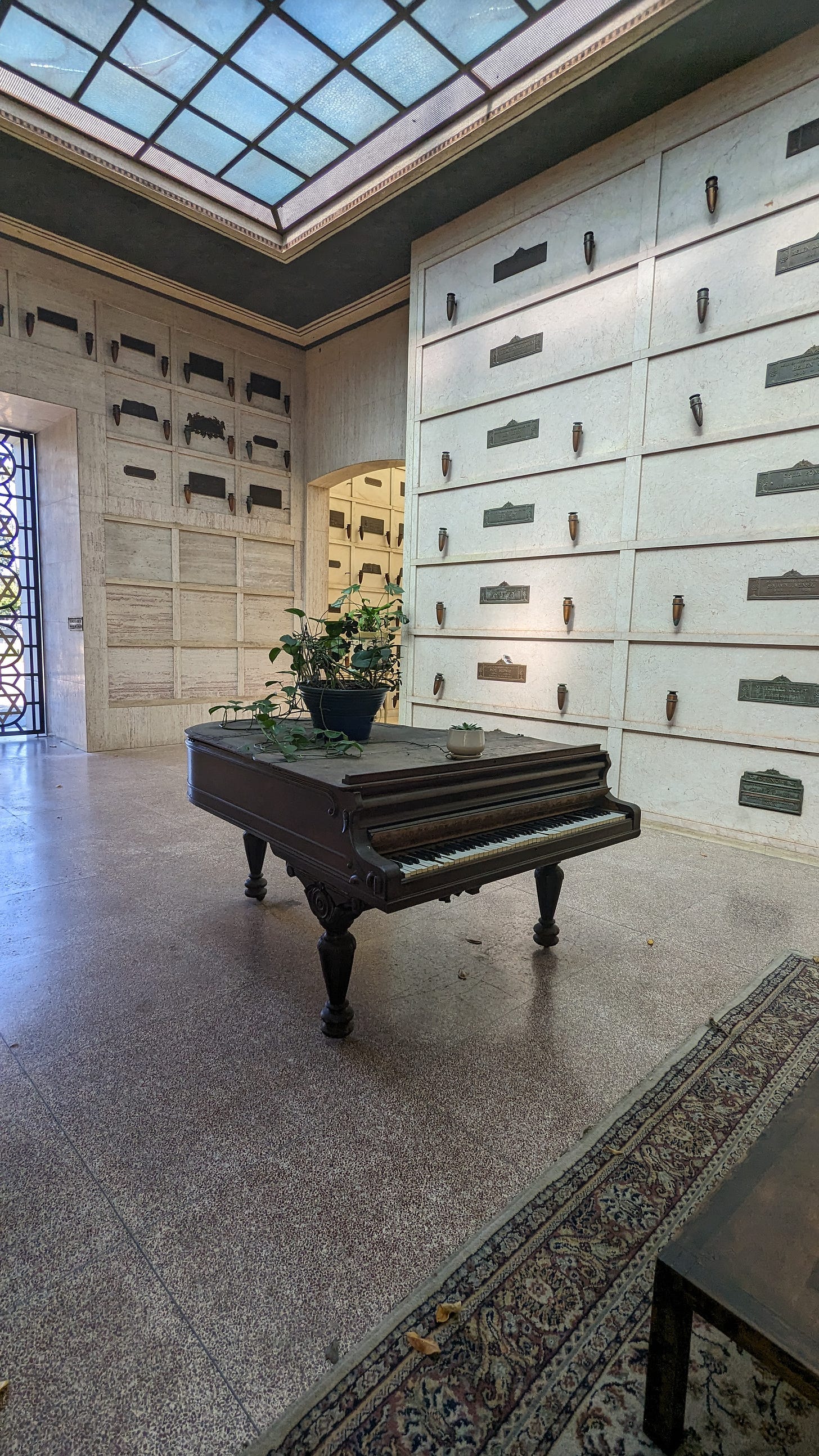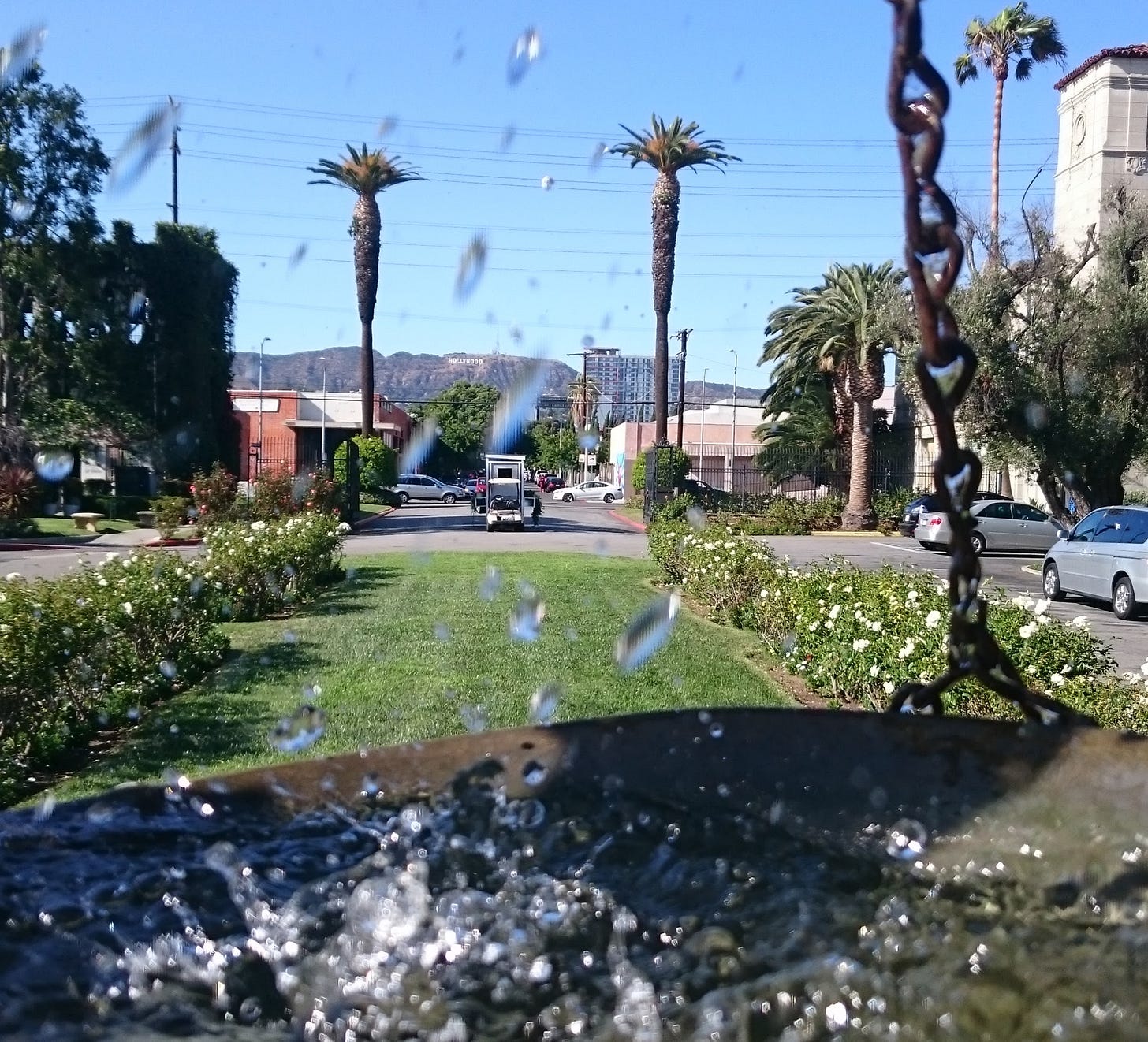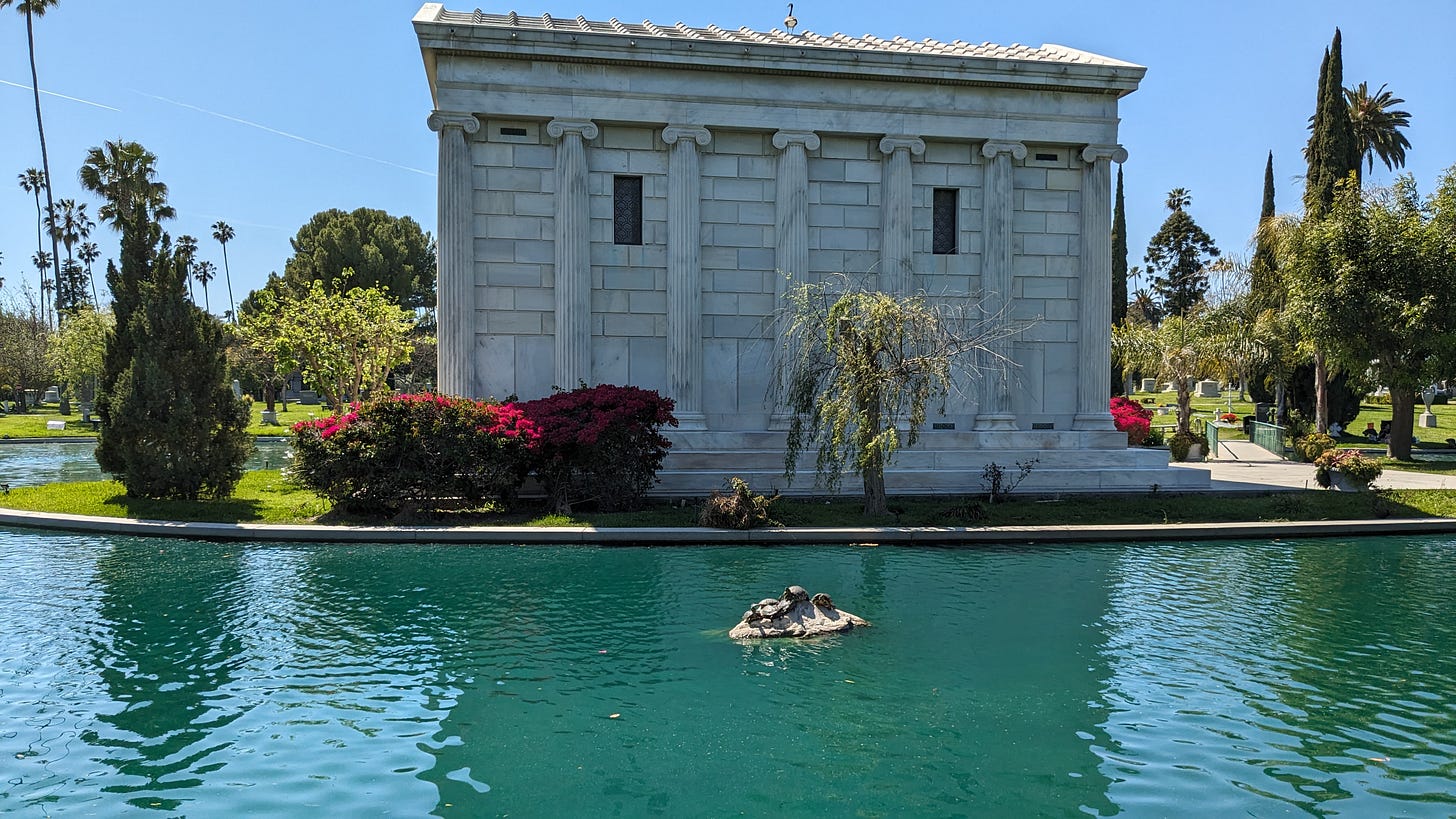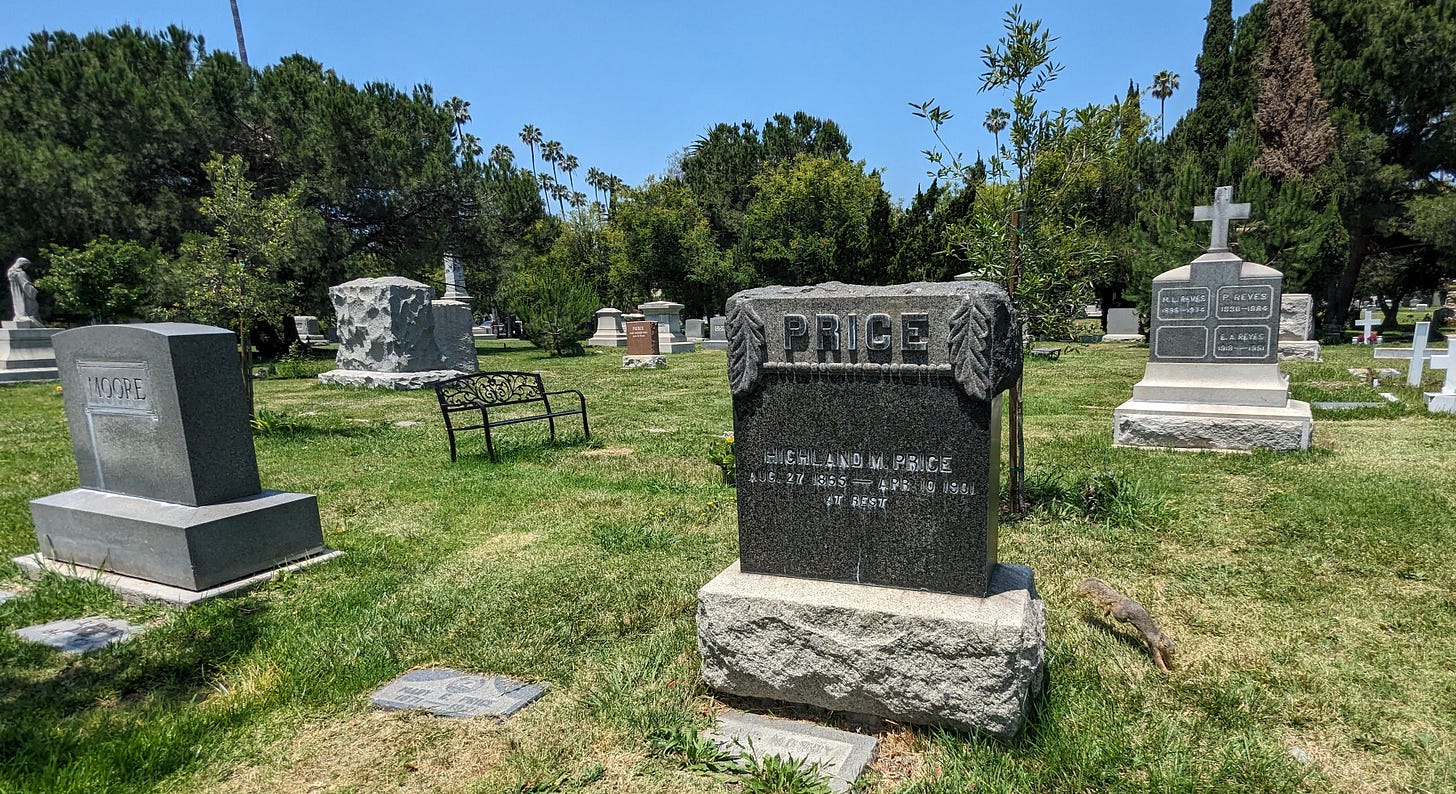The Wilcoxes, the Whitleys, and their cronies manifested their Hollywood dream in a perpetual present. They conjured a township where the flowers never stopped blooming, where seasons blurred, where life was a continuous carousel of picnics and parties at elegant homes similarly accoutred in the finest European designs and equipped with the same, latest appliances. A sinless, deathless, timeless, frictionless paradise.
These good Christian people hoped they’d left their sins in the past, in the soot-soaked factories and genocide-tinged prairies of the Midwest where they’d accumulated their filthy lucre. In the Hollywood hills they were born again, sanitized, bleached by the sun, ventilated by sea breezes, anointed in the golden California light of the immortals. It’s easy to forget the shadow of the tomb when you live so spotlessly, surrounded by spanking new roads, houses, acquaintances, fashions. For the new residents of Colegrove, Hollywood Ocean View, and Cahuenga Valley, Death was banished to the city, to Old Calvary or Evergreen or Rosedale cemeteries, a long—and elective— drive from Hollywood Boulevard. Out of sight, out of mind.
But Death comes for us all, even those dwelling in a new Eden at the end of the nineteenth century. Property developers across the USA were incorporating cemetery associations, hoping to cash in on demand for upscale eternal resting places. It was inevitable that one of the early Hollywood land speculators would consider maximizing profits by carving his subdivision into the smallest of tracts, the ones dug six feet deep.
It must have galled the community that one of their own, F.W. Samuelson, former president of the Nebraska National Bank, decided if he couldn’t sell plots to homebuyers, he’d sell graves instead. Samuelson had bought 60 acres to the south of Hollywood from the Gower family at the height of the mid-1880s boom, hoping to follow the Wilcox playbook and make bank, luxury lot by luxury lot. However, when demand collapsed and he couldn’t unload at any price, he floated the idea of turning his holdings into a for-profit cemetery.
Samuelson made his plans public in August 1897, when he set up the Hollywood Cemetery Association. A snarky piece in the Los Angeles Times, headlined “MORE WAYS THAN ONE-A NEBRASKAN’S SCHEME TO DISPOSE OF HIS PROPERTY”, villainizes the banker who “...brought with him a little money and a desire to accumulate unimproved property.” It accuses him of bluffing.
“Samuelson knew his neighbors would never peacefully submit to the location of a cemetery in the middle of their fruitful valley. He knew they would buy the property themselves before they would submit to such a thing.”
But none of the neighbors fell for the preposterous ruse. Instead, they banded together “in a soberly unanimous movement to abate a monstrous nuisance” and submitted complaints to the Los Angeles County Board of Supervisors. The article ends with a crie de coeur against “the rank awfulness of the Samuelson scheme, with its outrageous Nebraskan audacity, its contaminating exhalations, it’s—ugh.”
Over the next couple of years the County Supervisors tried and failed to enforce an injunction against the cemetery, claiming “the interment of animal matter in the soil is a menace to public health”. However, Samuelson’s defense, that his “land is two and one-half miles outside of the present city limits of the city of Los Angeles” and therefore beyond their jurisdiction, was irrefutable, and the judgment was eventually vacated on August 4, 1899.
Local farmer William Fay had one last go at halting “the Samuelson scheme”, claiming the burial ground would “greatly hazard the health, comfort and lives of his family”, who lived on a nearby Colegrove property. Fay listed specific reasons why the location was all wrong:
FAY’S FEARS (Oct 4, 1899)
Thinks Hollywood Cemetery Will Be Too Close to His Home
“…The land… is almost level and unsuited for burying purposes, being of a kind of soil which, during all dry seasons, is broken and cut by deep cracks and crevices, so that dead bodies buried there would become exposed to the air and noxious inhalations therefrom would corrupt the atmosphere thereabouts.
During the rainy season and in wet years, Fay avers, the land is unsuited for cemetery purposes for the reason that the soil is thoroughly saturated with water, which often stands within not much more than two or three feet of the surface.
“A grave in such times would become occupied with water, rendering the same most improper as a place of deposit for dead bodies,” says the complainant.”
Again, the Hollywood Cemetery Association was able to counter Fay’s apocalyptic opposition with a simple statement of intent. According to the Los Angeles Times report of the case on February 8, 1900, they informed the court of their “elaborate plans” to establish “a first-class cemetery, on wholly approved and modern methods of interment, and to make the plot one of the beauty spots of the vicinity and of country-wide fame.” It was enough for the case to be dismissed—by the plaintiff.
With all legal hurdles cleared, the HCA got to work. They purchased another 40 acres to make 100 in total. They spent $2000 hiring Cincinnati’s most celebrated cemetery planner, Joseph Earnshaw. Earnshaw, who trained under renowned landscape architect Adolph Strauch, had built his reputation over decades, designing a series of gracious green burying grounds back east. He began his career as Strauch’s civil engineer, pioneering the lawn park cemetery model at sites like Spring Grove Cemetery in Cincinnati; Forest Lawn Cemetery in Buffalo; Highland Lawn in Terre Haute, Indiana; and Prospect Cemetery in Toronto. The Hollywood Cemetery would be one of his finest, final projects—he died in 1906, just as his vision of rolling lawns and walkways, shaded by carefully positioned trees and shrubs, was blooming.
Earnshaw’s design rejected both the “broken teeth” aesthetic of traditional graveyards and the elaborate, often overwhelming Victorian funerary art crowding early nineteenth century garden cemeteries. His emphasis was on serenity, creating a space for people to picnic on a sunny day and think kindly of those slumbering beneath the well-tended grass. He worked with, rather than against, natural features of the landscape, turning the swampy area feared by Fay into an ornamental lake.
Hollywood Cemetery was the first to open in the Los Angeles area in more than fifteen years, the first one created in the new century, and it represented a radical new direction. The innovations won the Los Angeles Times over. The ‘Doings Of Builders And Architects’ round up of 21 July 1901 gushed over the HCA’s concept of a “cemetery [that] shall resemble a beautiful park, that in completeness and perfection of detail shall equal the most beautiful of the municipal parks of the country.” It also lauded the rules about perpetual care, and headstones limited to “twelve or eighteen inches” in height.
All this modernity was in stark contrast to LA’s existing burial grounds. None of them had been planned with post-railroad population growth in mind. And, in true Angeleno style, the city’s planners and developers wanted to eradicate sites they deemed no longer fit for purpose, regardless of their historical importance. The oldest, Old Calvary, founded in 1849, had already been decommissioned. It was closed in 1896, hundreds of bodies were exhumed and relocated to New Calvary, and a high school was built over the cleared land. This was not a good juxtaposition, with the Times reporting “shocking” desecration of the remaining graves on June 16, 1901:
“Expensive tombstones were overturned and smashed into pieces. Statues were pushed off their pedestals and broken, grave flowers were scattered and torn to bits. In one case, tin cans were mockingly filled with weeds and scraps of withered bouquets and placed where one of the marble figures had been.”
The Times added insult to injury, describing the cemetery as
“gone to rack and ruin. The paths have all disappeared, and people walk over the graves unknowingly. Weeds grow dank and high all over the place. The tombs are rotting and falling into decay. There are a few vaults of brick and stone, which present a shabby and forlorn appearance. In short, the old burying ground has all the pathos of anything that has been forgotten.”
Elsewhere in the city, real estate speculator Frank B. Harbert was gunning for West Adams’ Rosedale (founded 1884) in December 1904—despite, or perhaps because, his own father was buried there. He spoke to the Times about his fears that the twenty year old burial ground wouldn’t be able to survive competition from “the magnificent Hollywood Cemetery” and consequently would “degenerate to a garden of thistles and a melancholy ruin of ancient marbles like old Calvary…an eyesore and a nameless horror in the fashionable residence quarter of a great municipality.” His solution was to remove “every vestige of death and its presence” and turn it into Rosedale Park—much better for [his] property values than a boneyard. His lyrical vision was of park goers comforted by the knowledge “that over the graves of their loved ones the grass would be kept forever green, and that the shadows of great trees would fall calmly upon them in the hot flood-tides of summer sunshine.” Fortunately, Rosedale survived Harbert’s campaign and is to this day one of the most richly storied spaces in Los Angeles. Go visit, if you can.
Hollywood Cemetery officially opened for business with the interment of Highland Mosby Price, wife of local blacksmith Thomas Walter Price, on April 12, 1901. It rapidly became the place to no longer be. Prospective inhabitants were lured there with the same sales pitch used to sell the luxury homes to the north. A 1905 advertorial in the Times extolls the same Hollywood dream of “unobstructed view of both mountain and sea”, and the convenience of the Los Angeles Pacific electric line, before quoting Longfellow (“This is the field and acre of our God”) and declaring
“the management have co-operated with nature in establishing one of the most modern cemeteries in the world, and one that is acknowledged will rank with such celebrated eastern burying grounds as beautiful Mount Auburn just out of Boston, and historic Greenwood of Brooklyn, Memorial Park, enjoying the distinction of being the only one of its kind on the Pacific Coast.”
Many distinguished dead would follow Highland Price through the gates in the coming years, as would corruption, scandal, and legends galore. The first entombees were local dignitaries, familiar to us now only through the street names they bequeathed, but as the colony took root (and an actual movie studio opened on the southern half of the cemetery lot) magic would seep through the soil, making this an enchanted spot. But we’ll get to all that.

If you’re ever in the area, take a stroll with me around 6000 Santa Monica Boulevard. Come for the celebrity graves, stay for the peafowl, the swans (Helen and Zeus), the cats and the turtles. Take a moment to connect to the land and its enduring dream—it’s perhaps the only surviving place in the two-eight where you can sense what might have once been, back before the hell-cycle of constant destruction and “development” in this zip code. You can still see signs of the cracked soil Fay warned of, and while the swamp may have been coiffed into the Sylvan Lake and the Fairbanks Reflecting Pool, Egyptian and Canadian geese still acknowledge it as one of the wetland stops on their annual migrations. They’ve been visiting every spring and fall for centuries.
Hopefully, as the cemetery is now recognized as a landmark by both the National Register of Historic Places and the Los Angeles Cultural Heritage Commission it will remain a special, liminal space for centuries more—the only patch of ground on Earth that can truly claim to be ‘Hollywood Forever’.








Reminds me of the fantastic tour you gave me of the cemetery years ago. Would love to do that again!
Incredible read, thank you!